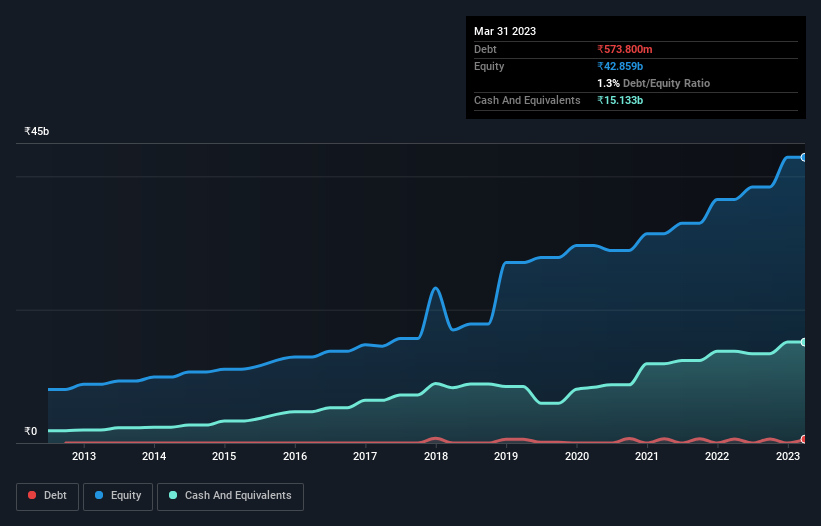Schaeffler India (NSE:SCHAEFFLER) Seems To Use Debt Quite Sensibly

David Iben put it well when he said, 'Volatility is not a risk we care about. What we care about is avoiding the permanent loss of capital.' It's only natural to consider a company's balance sheet when you examine how risky it is, since debt is often involved when a business collapses. Importantly, Schaeffler India Limited (NSE:SCHAEFFLER) does carry debt. But the more important question is: how much risk is that debt creating?
When Is Debt Dangerous?
Debt is a tool to help businesses grow, but if a business is incapable of paying off its lenders, then it exists at their mercy. If things get really bad, the lenders can take control of the business. However, a more frequent (but still costly) occurrence is where a company must issue shares at bargain-basement prices, permanently diluting shareholders, just to shore up its balance sheet. Of course, the upside of debt is that it often represents cheap capital, especially when it replaces dilution in a company with the ability to reinvest at high rates of return. When we examine debt levels, we first consider both cash and debt levels, together.
Check out our latest analysis for Schaeffler India
What Is Schaeffler India's Net Debt?
The image below, which you can click on for greater detail, shows that Schaeffler India had debt of ₹573.8m at the end of December 2022, a reduction from ₹607.0m over a year. However, it does have ₹15.1b in cash offsetting this, leading to net cash of ₹14.6b.

How Strong Is Schaeffler India's Balance Sheet?
Zooming in on the latest balance sheet data, we can see that Schaeffler India had liabilities of ₹13.9b due within 12 months and liabilities of ₹505.5m due beyond that. Offsetting this, it had ₹15.1b in cash and ₹10.7b in receivables that were due within 12 months. So it can boast ₹11.4b more liquid assets than total liabilities.
This surplus suggests that Schaeffler India has a conservative balance sheet, and could probably eliminate its debt without much difficulty. Succinctly put, Schaeffler India boasts net cash, so it's fair to say it does not have a heavy debt load!
Also positive, Schaeffler India grew its EBIT by 24% in the last year, and that should make it easier to pay down debt, going forward. When analysing debt levels, the balance sheet is the obvious place to start. But ultimately the future profitability of the business will decide if Schaeffler India can strengthen its balance sheet over time. So if you want to see what the professionals think, you might find this free report on analyst profit forecasts to be interesting.
Finally, while the tax-man may adore accounting profits, lenders only accept cold hard cash. While Schaeffler India has net cash on its balance sheet, it's still worth taking a look at its ability to convert earnings before interest and tax (EBIT) to free cash flow, to help us understand how quickly it is building (or eroding) that cash balance. In the last three years, Schaeffler India's free cash flow amounted to 43% of its EBIT, less than we'd expect. That's not great, when it comes to paying down debt.
Summing Up
While we empathize with investors who find debt concerning, you should keep in mind that Schaeffler India has net cash of ₹14.6b, as well as more liquid assets than liabilities. And it impressed us with its EBIT growth of 24% over the last year. So is Schaeffler India's debt a risk? It doesn't seem so to us. There's no doubt that we learn most about debt from the balance sheet. However, not all investment risk resides within the balance sheet - far from it. For example - Schaeffler India has 1 warning sign we think you should be aware of.
When all is said and done, sometimes its easier to focus on companies that don't even need debt. Readers can access a list of growth stocks with zero net debt 100% free, right now.
If you're looking to trade Schaeffler India, open an account with the lowest-cost platform trusted by professionals, Interactive Brokers.
With clients in over 200 countries and territories, and access to 160 markets, IBKR lets you trade stocks, options, futures, forex, bonds and funds from a single integrated account.
Enjoy no hidden fees, no account minimums, and FX conversion rates as low as 0.03%, far better than what most brokers offer.
Sponsored ContentNew: Manage All Your Stock Portfolios in One Place
We've created the ultimate portfolio companion for stock investors, and it's free.
• Connect an unlimited number of Portfolios and see your total in one currency
• Be alerted to new Warning Signs or Risks via email or mobile
• Track the Fair Value of your stocks
Have feedback on this article? Concerned about the content? Get in touch with us directly. Alternatively, email editorial-team (at) simplywallst.com.
This article by Simply Wall St is general in nature. We provide commentary based on historical data and analyst forecasts only using an unbiased methodology and our articles are not intended to be financial advice. It does not constitute a recommendation to buy or sell any stock, and does not take account of your objectives, or your financial situation. We aim to bring you long-term focused analysis driven by fundamental data. Note that our analysis may not factor in the latest price-sensitive company announcements or qualitative material. Simply Wall St has no position in any stocks mentioned.
About NSEI:SCHAEFFLER
Schaeffler India
Engages in the development, manufacture, and distribution of high-precision roller and ball bearings, and related components worldwide.
Excellent balance sheet average dividend payer.
Similar Companies
Market Insights
Community Narratives



